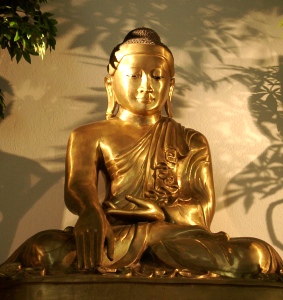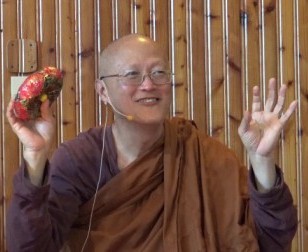Abhidhamma and Vipassanā

Knowledge of Abhidhamma can lead to more clearness in Vipassanā-practice, because we learn to understand, what we directly experience with Vipassanā. And because we know what and where the right way is and to what to pay attention, we will not lose our way or succumb to deceptions and illusions so easily. Abhidhamma-knowledge combined with Vipassanā-insight leads to wisdom and therefore to liberation through wisdom (paññā-vimutti).
 In Vipassanā-meditation we - for example - observe our mental states and emotions free of judgment in order to get to know them – in Abhidhamma we analyse them individually and explain them in their conditional relations, in order to eventually see them as they really are: Impermanent, unsatisfactory and not our self or property (anicca, dukkha, anattā).
In Vipassanā-meditation we - for example - observe our mental states and emotions free of judgment in order to get to know them – in Abhidhamma we analyse them individually and explain them in their conditional relations, in order to eventually see them as they really are: Impermanent, unsatisfactory and not our self or property (anicca, dukkha, anattā).Suitable meditations-objects for Vipassanā
Only "paramattha-dhammas" are suitable for Vipassanā-meditation. If we remain with concepts (paññatti) it is impossible to attain insight and knowledge. We have to get to the core of the concepts, the ultimate realities, have to comprehend these ultimate realities by their individual characteristics, observe them and penetrate to their universal characteristics:
If we know Abhidhamma, we know which objects are paramattha-dhammas and which not, and on what we have to pay attention, i.e. we know, if our meditation is alright or not, if it is true Vipassanā or not, and we can correct ourselves if necessary.
Vipassanā-ñāṇas

Before the meditator reaches the real steps of insight (vipassanā-ñāṇas), which eventually will lead to the moments of path-consciousness (magga-citta) and to the radical liberation, two preparatory insights or kinds of knowledge are necessary:
and differentiation of mind and matter
tions (of nāma and rūpa)
These two insights eradicate wrong view (diṭṭhi) and doubt (vicikicchā, kankhā) and therefore also are called the steps of "Purification of view" (diṭṭhi-visuddhi) and "Purification by overcoming doubt" (kankhāvitaraṇa-visuddhi).
A theoretical study of nāma (citta + cetasika) and rūpa, as taught in Abhidhamma, will be very helpful to clearly distinguish these two phenomena in the practice too, especially in Vipassanā-meditation. And the study of Paṭṭhāna, the conditional relations, will stimulate the insight-knowledge of cause and conditions.
Abhidhamma and Vipassanā belong together. Theory and practice are complimenting each other perfectly.
Mahāsatipaṭṭhāna-Sutta
In the Mahāsatipaṭṭhāna-Sutta (see sutta-text in Pāli), which usually is regarded as basis for Vipassanā-meditation, the Buddha explains four foundations of mindfulness - or rather four areas in which to develop and establish mindfulness. For each area several exercises of repeated reflection or contemplation (anupassanā) are mentioned and explained in more or less detail. There is a close connection between these areas and the ultimate realities (paramattha-dhammas) of the Abhidhamma:
– corresponds to matter (rūpa)
– corresponds to the mental factor (cetasika) feeling (vedanā)
– corresponds to consciousness (citta)
– mainly corresponds to the mental factors (cetasikas)
As every exercise of the Satipaṭṭhāna-Sutta is stressed to be practised "ātāpi, sampajāno, satima" (ardently, clearly comprehending and mindful), Abhidhamma explains us exactly which mental qualities and types of consciousness are meant: the cetasikas vīriya, paññā (ñāṇa), sati and mahākusala cittas.
For every exercise there is mentioned what else we should contemplate on the nature of our object:
object) or the arising-nature
ject) or the dissolving nature
nature of arising and dissolution
That is to say we should see and understand the conditions and conditional relations. That is exactly what is taught in the Paṭṭhāna of Abhidhamma.
Where does this practice lead to? In the sutta in each of the four areas it is said: For the overcoming of "abhijjhā domanassa" - and again two cetasikas are pointed out: lobha and vedanā (feeling of the quality mentally unpleasant).
In the sutta's introduction the Buddha expounded directly:
By this practice of Satipaṭṭhāna there will cease
and this practice will lead to
The knower of Abhidhamma understands very well, of what the Buddha talks here...
NOTES:
The Mahāsatipaṭṭhāna-Sutta was taught in detail by Sayadaw Dr. Nandamālābhivaṃsa during various courses. Link to his ebook: Perspective of Mahāsatipaṭṭhāna Sutta
Sayadaw Dr. Nandamālābhivaṃsa has given a popular Dhamma talk in Burmese on "Samatha and Vipassanā, concentration and insight meditation." An English translation by Sayadaw himself, edited by Agganyani, is available as ebook here: Samatha and Vipassanā (PDF, 426 KB)
Vipassanā talks by Venerable Chanmyay Sayadaw (several pdf ebooks)
See in Books on this website, "V" and "Vipassanā talks". Bhante Sujiva: Videos of 20 Dhamma talks during his Vipassanā retreat 2108 in Italy with a lot of reference to and application of the Abhidhamma:
Bhante Sujiva: Videos of 20 Dhamma talks during his Vipassanā retreat 2108 in Italy with a lot of reference to and application of the Abhidhamma:
Youtube link

